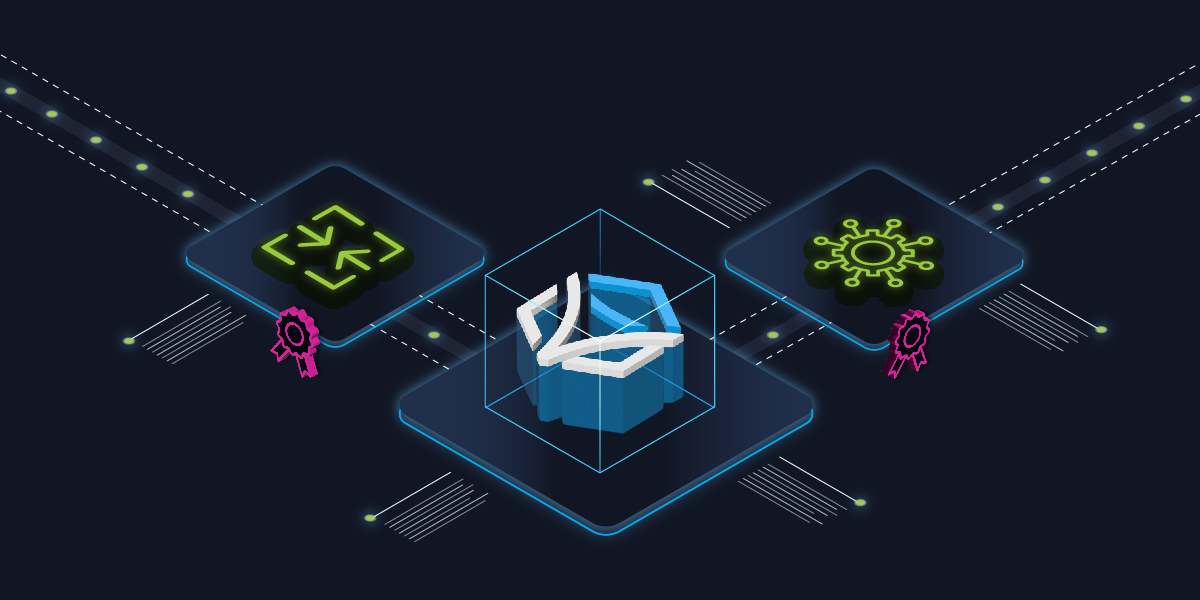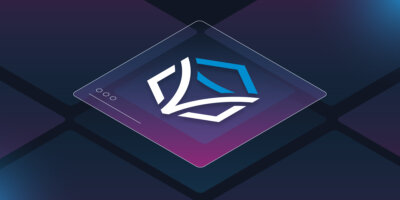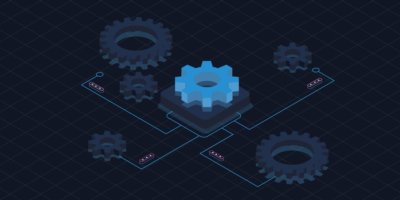Itential was created as modern infrastructure moves from human centric CLI interfaces to machine centric APIs. This evolution allows our industry to transform how we operate networks and infrastructure at scale. Our API-first approach to network automation and orchestration is redefining how our customers manage complex, distributed networks.
As network environments continue to become more distributed and complex, the number of external tools will only grow, positioning the “integration tax” as a significant threat to network automation success. Itential’s two recently granted patents are a testament to the unique value of our approach to progressing network programmability. Together, they deliver a unique set of capabilities for organizations to eliminate the integration tax and achieve new levels of efficiency with automation.
Itential’s Newly Issued Patents for Its Network Integration, Automation, & Orchestration Technology
Data Federation
Systems and Methods for Dynamic Federated API Generation (US 11,665,241 B1)
The first patent generally centers around our unique federation capabilities, which allow Itential to act as a universal intermediary or translator between distributed networks and any number of users and applications making network requests. This approach enables our customers to build networks that encompass many different network domains, devices, locations, and networking and IT systems, and then use them to serve business needs with full flexibility.
Why it Matters
This patented approach to data federation solves a key challenge for modern network teams by removing the main barrier between business logic and network infrastructure — how to effectively map business needs in a complex, diverse network environment. Network requests can be made in accordance with business logic and then the federation layer will identify all relevant entities of a given type or category and apply the changes, with no burden placed on the person or application making the request.
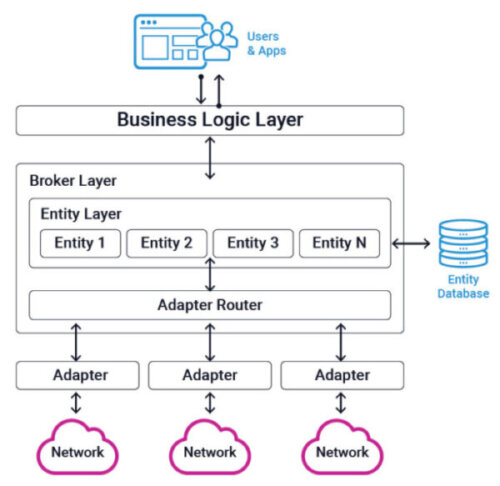
The above diagram shows how the Itential broker layer’s federation capabilities connect different networks to sources of business logic that drive automation requests.
For example, if configuration changes must be made to a certain type of router from a specific vendor, but those routers are distributed across many different networks or multiple controllers, such as SD-WAN branches, then the federation layer enables a network engineer to not be concerned with where or how to apply the configuration changes. This is a simple example — as change processes grow more complex, federation becomes even more useful. A sprawling enterprise network can be challenging to manage successfully without this federation layer.
Itential’s patent tackles the problem from two sides: the process for generating a federated API of all relevant network resources, and the process for intelligently routing API calls to the appropriate networks and systems. In this way, Itential acts as a universal translator of sorts between distributed network infrastructure and the multiple methods used to make service requests, which removes the barriers that can make network expansion difficult.
When network infrastructure decisions are driven by business need rather than infrastructure limitations, this improves the agility of the business. Many customers have felt ‘locked-in’ by their infrastructure vendors as the complexity of switching vendors was very cumbersome. Given the velocity and breadth of networking options in the cloud and ‘aaS’ (as a Service), it is critical that enterprises take advantage to support their critical business priorities.
Data Transformation
Systems and Methods for Improved Data Modeling and Translation (US 11,354,491)
The second patent generally centers around one of the key differentiating components of the core architecture of the Itential Automation Platform, a component that enables the platform to provide the highest level of data structure flexibility of any orchestration platform on the market. As networks continue to become software-centric, we have seen a number of protocols (NETCONF, REST, gPRC, etc.) and data formats (YANG, JSON, Protobuf, etc.) which automation and orchestration platforms need to support.
Why it Matters
The methods covered by the patent address another one of the challenges that automation and orchestration teams face today — how to create and execute orchestrations across multiple vendors, technologies, and domains without becoming bogged down with the specific syntax and data formats of each system and model.
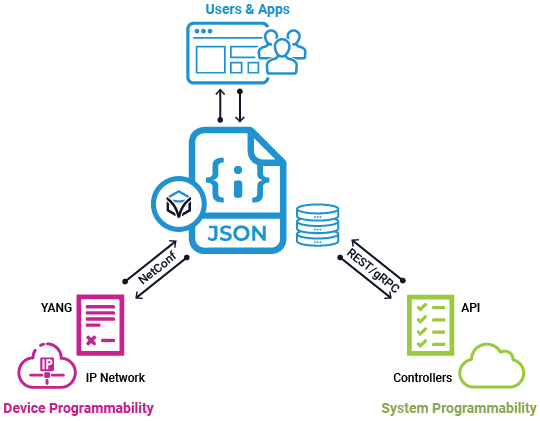
The above diagram shows how Itential’s JSON-based data translation capabilities enable bidirectional communication between all networking components and users.
To better illustrate the problem, here’s an example. In recent years, network equipment vendors have moved away from CLI-centric, proprietary command structures toward the YANG format, to achieve greater device-level programmability. At the same time, cloud teams focused on system programmability through APIs using REST or gRPC to implement services and connections between services via controllers. While each of these approaches does a good job of describing their native environments, neither can efficiently model the other; it is difficult to model cloud resources in YANG, and systems that use APIs have been limited in their ability to model complex network environments.
Itential’s patented solution provides a mechanism for translating multiple data structures (such as YANG for network and REST/gRPC for service and service topologies) into a common, flexible, human readable format: JSON. While the name JavaScript Object Notation doesn’t scream “user readable,” it is surprisingly easy to define and understand data that is represented in JSON.
The patent generally defines the methods for translating from the specific languages into a common language that end users and applications can more easily interact with. It also defines the method for translating the user/application input back into the specific language so the appropriate changes to the network and systems are formatted and routed properly.
The implications of this patent are substantial for teams that have struggled with delivering multi-domain, multi-vendor solutions. Until now, their only options were to maintain multiple stacks or attempt to use tools and scripting to bridge between systems and formats — an exercise that is logical but has become increasingly time consuming and difficult.
What Makes Itential Different
The capabilities defined in these patents have enabled Itential users to increase the velocity of new capabilities and services for their infrastructure, with greater flexibility to support new and evolving use cases. With our robust integration capabilities (that extend even further than just our two patents), Itential customers are running automations at scale with over 200+ out-of-the-box integrations for customers to use on day one. The combination of our unique federation capabilities and our data modeling and translation methods has enabled our customers to move faster and do more with their networks, making the network more agile and responsive even as the underlying infrastructure complexity increases across hybrid, multi-cloud infrastructure.
The Itential Automation Platform is the only solution that can integrate with and transform any network (physical, virtual, and cloud) and any IT system, transforming the data into a common language (JSON) to deliver a unified, real-time federated view of the resources and data. It is the only solution that federates all of your networks so that business logic can be applied universally.
To learn more about Itential’s unique, patented approach to integration, transformation, and federation, check out this new white paper or watch the webinar “How Itential’s Patented Integration Innovations Accelerate Network Automation & Orchestration Adoption” here.

